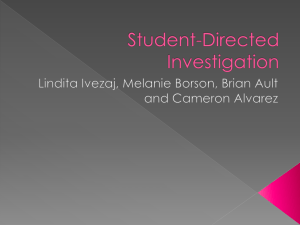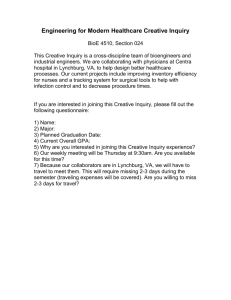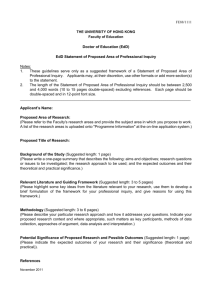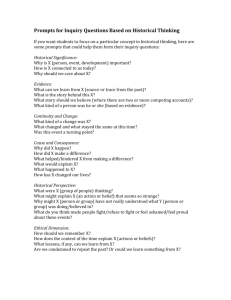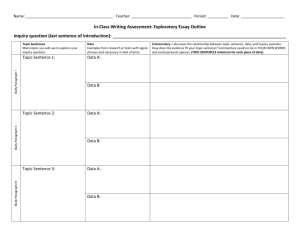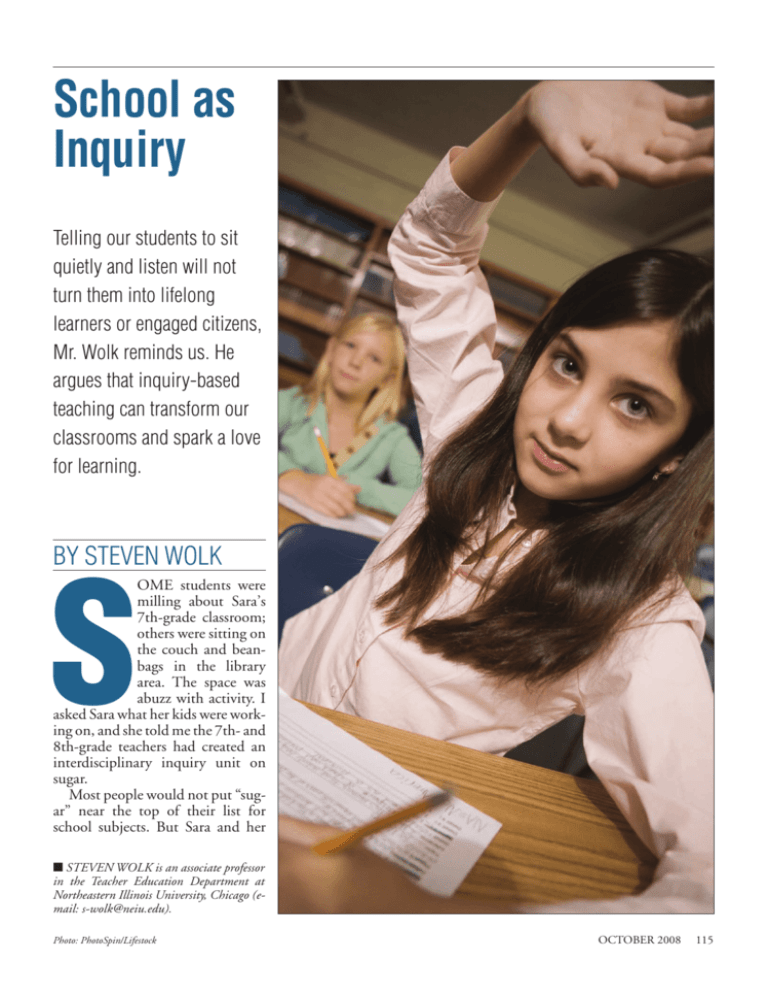
School as
Inquiry
Telling our students to sit
quietly and listen will not
turn them into lifelong
learners or engaged citizens,
Mr. Wolk reminds us. He
argues that inquiry-based
teaching can transform our
classrooms and spark a love
for learning.
BY STEVEN WOLK
OME students were
milling about Sara’s
7th-grade classroom;
others were sitting on
the couch and beanbags in the library
area. The space was
abuzz with activity. I
asked Sara what her kids were working on, and she told me the 7th- and
8th-grade teachers had created an
interdisciplinary inquiry unit on
sugar.
Most people would not put “sugar” near the top of their list for
school subjects. But Sara and her
S
■ STEVEN WOLK is an associate professor
in the Teacher Education Department at
Northeastern Illinois University, Chicago (email: s-wolk@neiu.edu).
Photo: PhotoSpin/Lifestock
OCTOBER 2008
115
colleagues at Augustus Burley School, a Chicago pub- not pulled by a test, it was pushed from within. That
lic school, are transforming their curriculum into passion and wonder is what sent Shakespeare to the
what they call “inquiry explorations.” The topic of stage, Darwin to the Galapagos, and Jane Goodall to
sugar was suggested by Dennis, the math teacher, who the chimpanzees. And it should be what drives our
schools.
had read Sweetness and Power: The Place of Sugar in
So, I have a question. Imagine your students gradModern History.1 From that idea, a nine-week investiuating. They know all of the facts and skills taught to
gation of sugar was born.
Teachers started by asking students, “What comes them over the years. All of them have learned fractions
to your mind when you hear the word
‘sugar’?” The students gave the expected replies of candy and cake.
If my great-grandma walked into a classroom
Then the teachers showed the film,
“Sugar Cane Alley,” about the optoday, she would know exactly what to do: sit
pressive sugar industry in the French
down, be quiet, listen to the teacher.
colony of Martinique in the 1930s.2
This filled the students with totally
different thoughts about sugar. Suddenly, those little packets on every restaurant table and earth science. They can read a great novel and
had an entirely new meaning. From there, Todd, the write a perfect persuasive essay. Let’s even say — rescience teacher, explored sugar from a scientific per- member we’re pretending — that all of your students
spective, Dennis had students look at the economic have terrific standardized test scores. However, they
and commodity dimensions of sugar, and Sara — have no passion, no wonder about life and the human
teaching both language arts and social studies — condition. They care little for the world. They are inhelped the kids to investigate today’s sugar industry different to nature and the environment. They have
and, in particular, life in the Dominican Republic no intellectual curiosity. They don’t like to read, so
they hardly ever pick up a book or a newspaper. They
sugar-worker settlements, known as “bateyes.”
This sugar “exploration” is a good example of rarely vote, they have little knowledge of what is hapteaching through inquiry. In my previous Kappan ar- pening in the country and the world, and they fill
ticle, “Why Go to School?” (May 2007), I argued that their days largely with working, watching TV, surfing
most people believe our schools’ primary purpose is the Internet, and shopping. So, here is my question:
to prepare children for their future as workers, rather As an educator, have you succeeded?
To me, the answer is obvious. Schools have not sucthan to educate them as complete human beings. This
narrow aim of preparing children for employment ceeded. Schools have been successful in creating conmeans that our schools do not teach a love for learn- testants for “Jeopardy,” receptacles for inert facts and
ing, caring and empathy, moral consciousness, media skills, what David Perkins calls “couch potato knowlliteracy, social responsibility, ecological literacy, peace edge.”3 Schools help create workers and consumers,
and nonviolence, creativity and imagination, intellec- but what are these students going to do with that contual curiosity, and global awareness. Rethinking curtent? Not much. This means that even if our schools
ricula as inquiry is one of the best ways we can teach “succeed” — based on our current definition of sucthis essential knowledge and make content and skills cess — in reality they fail because we did little more
infinitely more meaningful.
than give children the technical skills to pass through
the education system in order to get a job. Can we call
that an education?
WONDERING ABOUT THE WORLD
Of course, schooling is not an either-or proposiMost children are not going to be an Einstein or a tion. We do not have to choose between students
Thoreau, but they can live like them, in awe of our knowing important content, being prepared for colexistence, filled with questions, and excited to observe lege and employment, developing empathy and
and understand the world. Thoreau and Einstein fol- moral identity, having intellectual curiosity, and belowed two very different paths, but their inquiry ing involved in their communities. We can aim for all
about the world required common habits of mind. To of these and more. And teaching through inquiry can
them, the world was something to study, to explore, help us succeed. But make no mistake: Inquiry-based
to wonder about. They had passion; their inquiry was teaching is a profound change from business as usu116
PHI DELTA KAPPAN
remember much about the Jamestown Colony.”4
Randy was not the exception in this classroom. The
researchers said that most of the students could not
articulate what they were just taught at length. Rather
than a solid understanding of Colonial history, they
had what the researchers called a “factual stew” of
knowledge.
My graduate students do similar interviews and get
the same results. Students almost never talk about the
content in any articulate or enlightened or passionate
way. When students can talk about a topic with at
least a modicum of coherence, it happens to be a subject they love, which makes perfect sense. If you love
TRANSMISSION TEACHING AND THE ILLUSION
science, you’ll learn more of it, even from a textbook.
OF LEARNING
I also have my students ask them about their outsideHave you ever talked with students about what of-school learning. The same children who are lost for
they have learned? I don’t mean just asking them what words when asked about their in-school learning can
they’re studying in math or English, but asking them hardly be quiet when talking about learning how to
about the specific topics they were taught. I do this skateboard or dance or play the guitar. I have to be
often. The results are not surprising, but they are careful with this assignment because this happens so
often that my students can become
disillusioned.
Why are students not learning
Teaching through inquiry considers our work a
most of what they are taught in
failure if students do not leave school filled with school? Primarily because of the
19th-century model of transmission
questions and the yearning to explore them.
teaching that still dominates our
schools and curricula. The signs and
symptoms of transmission teaching
shocking. I don’t ask them about recent topics in are obvious: students sitting in their desks for most of
school; those are too fresh in their minds. I ask them the school day, teachers doing most of the talking,
about topics they studied months and years ago. Af- textbooks and worksheets as the primary resources,
ter all, if they really learned that content, they should assessment focused on tests and quizzes. Contrary to
popular belief, this model has changed little in the
still know at least a significant amount of it, right?
But when I ask what they studied in science or so- past century.5 If my great-grandma walked into a
cial studies earlier in the year or during the previous classroom today, she would know exactly what to do:
year, there is a long silence as they dig through their sit down, be quiet, listen to the teacher.
When students sit at their desks as teachers talk, are
brains to remember the topics they were taught. And
they
really hearing what the teacher is saying? Are they
then I’ll either hear one sentence, “I don’t remember,”
or I’ll get bits and pieces of information that add up intellectually engaged? Mihaly Csikszentmihalyi gave
to very little. Some researchers have done this as well. high school teachers pagers that beeped randomly
They’ve sat down and interviewed students about during school. When the pager went off, the teacher
their learning (or their not-learning) in school. In one and students completed a questionnaire with such
study, they interviewed 8th graders after the students questions as, What are you doing right now? and
had an extensive unit on Colonial American history. What are you thinking about right now? What were
these students thinking about? The upcoming weekHere is a description of the typical results:
Following a lengthy unit on British colonization, end, what they watched on TV the night before, and
the interviewer says to an 8th-grade student, “Tell me lunch.6
If we want students to care about learning and the
about the Jamestown Colony.” The student, Randy,
replies, “Jamestown, I think it was, like, the colony world, then we need to make school, their learning,
that. . . I remember it was the colony. . . I don’t real- and the world interesting and purposeful. To do that,
ly remember much. I just think, um. . . I don’t really we must toss the transmission model of teaching inal. Inquiry-based teaching transforms the aims of
school from short-term memorization of facts into
disciplined questioning and investigating. Teaching
through inquiry cannot be taken lightly or planned
quickly. And inquiry-based schools at their very best
do not just practice inquiry with their students, they
also invite — even expect — teachers and administrators to use inquiry to improve their practice. In this
sense, inquiry becomes far more than a pedagogical
theory or a teaching method; it becomes a way of life
inside school.
OCTOBER 2008
117
to the bin of obsolete educational practices and make
our classrooms bloom with the intellectual and creative buzz of inquiry.
WHAT IS INQUIRY-BASED TEACHING?
Inquiry is the opposite of transmission. Walk into
a classroom about inquiry and you will not see students sitting passively. You would see an active environment, a true community of learners. Students’
minds are engaged. The classroom is filled with the
voices of children taking an active role in their own
education.
The very idea of curriculum is redefined through
inquiry. Curriculum is not just the facts and skills we
teach, but the knowledge we create together and the
understandings and connections that each learner
makes from that knowledge. Today, we consider our
schools great successes if children graduate with all the
answers. Teaching through inquiry considers our
work a failure if students do not leave school filled
with questions and the yearning to explore them.
Science is the one subject that almost everyone
agrees should be inquiry-based. That is because inquiry is an inherent part of doing science. I can’t
imagine anyone advocating science education that
did not involve students spending the majority of
their time asking questions, mixing chemicals, dissecting flowers, observing ants, and forming hypotheses before they try them out. Four major science and
education organizations — the National Science
Foundation, the American Association for the Advancement of Science, the National Research Council, and the Northwest Regional Educational Laboratory — have lengthy publications specifically on
teaching science as inquiry.7 These organizations
know the best way to teach science to children and
young adults is to have them actually experience the
scientific process — as much as possible — like real
scientists. Unfortunately, too many people believe
that using the same methods in other subjects is controversial or “progressive,” rather than just good
teaching.
If you do a Google search on the phrase “inquiry
cycle” and then click on “images,” up pop diagrams
showing somewhat different, but similar, processes.
Most include these basic steps:
Ask questions.
Investigate the questions.
Create something to show what you found.
Share what you created.
118
PHI DELTA KAPPAN
Reflect on your work.
Possibly act on your inquiry.
Ask more questions.
While I like the minimalism of this, it also oversimplifies the process. Doing inquiry in any discipline
(including science) is not strictly linear. Inquiry is a
messy process and at times idiosyncratic. If I were to
diagram the process of inquiry it would look something like Figure 1.
FIG. 1
The Process of Inquiry
Ask Questions
Possibly Act
on Your Inquiry
Plan
Reflect
Discuss
Debate
Ask More
Questions
Make
Reflect on Your Inquiry Connections
Rethink Inquiry
Investigate Questions
Create Something
Share What You Created
It’s a common mistake that only the “investigation”
part is the inquiry. That is what most people equate
with “research.” But it is the entire experience that is
the inquiry. The teacher facilitates the work of students as they work their way through the outer ring
of the cycle. Most, if not all, of the investigation and
creation phases are done by students in the classroom
(not at home) where the teachers can help them
through every step. Teachers make sure the elements
on the inside of the cycle — reflection, discussion,
rethinking — are an essential part of the inquiry experience.
Even my own diagram oversimplifies the process
because it ignores the planning teachers must do before they even mention an inquiry question to their
students. Having questions that guide inquiry is key,
but behind the questions must be what Selma Wassermann calls the “big ideas.”8 The big ideas are the critical knowledge about the topic — written as explicit
statements — that the teacher believes must be understood for students to have a truly educational experience. For example, if a class is investigating what we
should eat, some of the big ideas I would include are:
• Statistically, the United States is the fattest coun-
hands-on teaching is not about inquiry because it is
not framed around questions, does not explore “big
ideas,” is driven primarily by the short-term memorization of facts, and rarely involves analyzing multiple perspectives. Having students make a diorama of
an ocean may be “hands-on,” but that alone will do
nothing to help them investigate the inquiry question, “How are humans affecting our
oceans?”
A culture of inquiry happens when teachers
Inquiry is also not “discovery learning.” It is not a free-for-all, and it is
breathe inquiry as a part of their lives.
not about letting students study whatever they want. Rather, inquiry-based
nomic status, with people in poverty eating lower teaching is collaborative, investigative, and deeply inquality food, having a higher concentration of fast- tellectual. The teacher has a responsibility to make the
food restaurants in their neighborhoods, and having inquiry experience purposeful and highly thoughtful.
Teachers are the primary architects of the learning exless access to quality health care.
• Most food sold in traditional grocery stores is perience.
Teaching through inquiry does not mean that a
highly processed.9
Without the big ideas, an inquiry becomes little teacher never lectures or never does whole-class inmore than a friendly version of reading a textbook or struction. There are certainly times for both. Howeva “fun activity.” With big ideas, a teacher can chal- er, the inquiry process does not silence or disregard
lenge students to think far beyond the sanitized con- students’ interests. There must be time for students to
tent of a textbook. Wasserman writes, “A teacher pursue or discuss their own questions and ideas (with
skilled in the use of provocative and probing ques- the teachers’ guidance) and to make some of the detions and guided by big ideas will lead students to dig cisions regarding their learning. So the process refor the gold within the experience, putting the big quires the teacher to find the just-right equilibrium
between control and explicit curricular objectives on
ideas under the lens of critical examination.”10
But more than merely engaging students in au- one end and student interest and autonomy on the
thentic inquiry investigations, we want to immerse other.
them in a culture of inquiry. I can’t reduce this essence
of inquiry to a recipe. A culture of inquiry happens
COMMONALITIES OF INQUIRY
when teachers breathe inquiry as a part of their lives.
Inquiry takes different forms depending on the disAs Connelly and Clandinin point out, “The kind of
teacher that we are reflects the kind of life that we cipline or the questions you’re investigating. Inquiry
lead.”11 The best teachers I know aren’t good just be- looks different in science classes and reading classes.
cause of what they do in their classrooms for six hours But there are universal features in all inquiry-based
teaching.
a day, they’re good teachers because of how they live
Authenticity. All inquiry learning is real — or as
their lives 24 hours a day. These teachers live a life
filled with learning, thinking, reading, and debating. real as it can be in the context of a school. Learning
Because inquiry is an important part of their lives, in- outside school is so successful — and often seems efquiry becomes an essential part of their classroom.
fortless —because it is real learning done within real
contexts and for real purposes.12 Outside school,
everything has real purposes. In school, there is little
WHAT INQUIRY IS NOT
immediate internal or mindful purpose from the
One of the most abused phrases in education is learner’s perspective. Learning that is purposeless is
“hands-on.” While I agree that “hands-on” teaching like a ship without a rudder; it will stay afloat and look
isn’t as boring as sitting and listening to a teacher talk like a mode of transportation, but it gets us nowhere.
for most of the day, hands-on teaching is not synonyThe Work Space. A space that is about open inmous with inquiry-based teaching. In fact, an essen- vestigations does not look like a traditional classroom.
tial part of inquiry — engaging in discussion and de- Outside school, many spaces are designed specificalbate — would not be seen as “hands-on.” And most ly for inquiry-type activities: workshops, laboratories,
try in the world, suffering from an obesity epidemic.
Nearly two-thirds of Americans are overweight or
obese.
• What we choose to eat — and our obesity — are
leading causes for heart disease, cancer, diabetes, and
high blood pressure.
• What we eat and obesity are related to socioeco-
OCTOBER 2008
119
My friend Chuck Cole taught middle
school science for more than 30 years.
When his 7th graders studied “atoms,”
he also had them read John Hersey’s
classic nonfiction book, Hiroshima,
about the dropping of the atomic bomb.
Here is some of Chuck’s reasoning,
including some of his “big ideas” for
using the book:
On one level [reading Hiroshima] was an
attempt to illustrate and explain a science
concept. But then I realized that there was
also a total disconnect in my students
between hearing about the atomic bomb
being dropped and an awareness of what that
actually meant in real lives. I saw enormous
teaching opportunities and possibilities in it.
They just jumped out of every page — the
scientific and the social, but also all sorts of
other connections. There’s vocabulary,
history, geography, the math (what does 20
kilotons mean?). But underneath it all,
emerged the unimaginable horror
of the event.
The kids always wanted to know if dropping
the bomb could have been avoided. And that
allowed me to help them discover a bit of the
nature of political leadership, and what
awesome responsibility leaders really have
— that they’re people just like us in some
ways, who have to make huge decisions.
Someone had to give the O.K. to drop that
bomb. All of the goals and reasons for
reading it in class couldn’t have been clear
and obvious from the start. I had to discover
them too, although I knew there was a lot of
potential for examining the politics and ethics
of the event. Reading that book was like
jumping into another universe.
120
PHI DELTA KAPPAN
ateliers, book clubs, think tanks, colloquiums, roundtables, children’s museums, studios. In all of these
spaces, the people are active; they are busy doing
things and engaged in purposeful pursuits.
Asking Questions. Questions fuel the inquiry
(along with big ideas and goals). Usually an inquiry
unit will be framed by one or more questions. These
are often called “essential questions” or “guiding questions.”13 Rethinking curriculum as questions is a profound change.
Investigations. Once we have a question or set of
questions (and the teacher has determined the big
ideas), we want to investigate that question. The exact nature of an investigation would differ depending
on the question and the discipline. Students can do
typical library and Internet research, conduct surveys,
interview people, write to e-pals in other countries,
watch films, listen to music, and read short texts
(newspapers, poetry, speeches, letters, short stories,
etc.). And teaching with literature is a powerful way
to inquire in all disciplines.
Real-World Resources. Imagine you want to learn
about the Vietnam War. I’ll give you two options: You
can use any real resources you can find in the world,
including books and articles about the war, interviewing people who lived through the war, and watching
movies and documentaries about the war. Or you can
read Unit 9, Chapter 30, Lessons 1, 2, and 3 in Creating America: A History of the United States, published
by McDougal Littell. Remember, we’re assuming you
want to learn about the war, not just get it done quickly. Which would you choose, the world or the textbook?
Chances are you’d choose the world, and I don’t
blame you. Why? Because it’s a lot more interesting!
If that is true for an adult, then it should also be true
for an 8th grader. In life outside of school, we would
never read a textbook, we would read real texts that
are absorbing, focused, well-written, provocative, and
emotional.
Multiple Perspectives and Multiple Answers.
Stimulating arguments are a by-product of an inquiry
classroom because an inquiry-based classroom challenges students to see an issue from multiple perspectives and to answer questions that do not have one
correct answer — and both are habits of mind that are
vital in a democracy.
Dialogue and Discussion. Inquiry learning cannot happen in an academic culture of silence. Roger
Simon wrote, “An education that creates silence is not
an education.”14 Talk and inquiry are deeply symbiotic. The process of inquiry nurtures good talk, and that
good talk furthers the inquiry. This discourse must
not be limited to classes in the social sciences and humanities. Math and the sciences also are rich with possibilities for discussion.
Creating. Inquiry-based classrooms are busy with
learners writing stories, newspapers, magazines, and
speeches; creating web sites and PowerPoint presentations; drawing artwork; performing plays; building
models; painting murals; producing films; and designing posters, lab reports, and brochures. The act of
creating something is vital because students are shaping an idea into an artifact. That act of creation teaches students to value and appreciate the thought and
discipline required to produce excellence and to feel
the pride that comes with making something with
their own hands and minds.
Agency. Jerome Bruner defines “agency” as “taking
more control of your own mental activity.”15 Nurturing agency in children involves honoring their unique
construction of knowledge, integrating choices and
ownership into the curriculum, and teaching students
to be metacognitive, that is, to help them to consciously think about their thinking and learning. As
teachers, we want children fully engaged in learning
and in deciding the direction and substance of their
learning.
Discovery. While I have written that inquiry is not
“discovery” learning, there should still be a sense of
discovery. One of the tragic facts about most schools
today is their distressing lack of playfulness. Sadly,
there isn’t nearly enough tinkering going on in our
schools. The only place kids can “officially” tinker is
kindergarten. Along with discovery, playfulness, and
tinkering, inquiry benefits from another void in our
classrooms: spontaneity. Unfortunately, in our zeal to
control every aspect of the school day, students lose
out on the possibilities that can emerge from the unexpected and the uncertain.
Joy. How did joy become the enemy of education?
I get a clear sense from many critics of progressive education that children are not supposed to enjoy
school, that school is supposed to be work. They believe that if students are enjoying school, then our
teaching is not “rigorous” enough. But can’t our
schools have both academic integrity and joy in learning?
The Skills and Tools of Inquiry. One of the most
important purposes for inquiry-based teaching is to
teach the skills of inquiry. While this includes proficiency in finding resources and doing “library” type
research, inquiry also includes collecting and analyzing data, developing observation skills, interviewing
and surveying, technical and creative writing skills,
creating purposeful questions and hypotheses, computer skills, reading for information, aesthetic abilities, and skills in discourse and argument. Learning
the skills of inquiry also means learning that inquiry
requires self-discipline along with a sense of playfulness and joy.
STUDENT-INITIATED INQUIRY
Although inquiry is not entirely student-generated, students still need some choice in what they learn.
Imagine you’re teaching 4th grade and one of your
students says, “I’d like to learn about frogs.” If you’re
in a typical 4th-grade classroom, you’d say something
like, “That’s nice” or “You should go to the library after school and check out a book on frogs.” But that’s
about it. End of frogs. And perhaps the end of that
student’s interest in frogs.
But now imagine that your school has created a daily one-hour class period called Exploratory. During
that hour, students work on topics and questions that
interest them. These student-initiated projects are
shaped — with the teacher’s help — into purposeful
investigations. So, now when that student says, “I’d
like to learn about frogs,” you can answer, “Wonderful! How about studying frogs for your new Exploratory project?”
I often hear educators say that they want their students to be “lifelong learners,” but do they really mean
OCTOBER 2008
121
that? Is it possible to nurture that love for learning and
disciplined inquiry in children if teachers always tell
them what to learn, when to learn, and how to learn?
Giving children time in school to inquire into topics
and questions that they initiate may be the most important way to arouse wonder and passion in children
and the will to pursue a life of learning.
WHAT ABOUT CONTENT? STANDARDS? TEST
SCORES?
Too often, learning through inquiry and learning
content are seen as being mutually exclusive. This is a
false dichotomy; it is not how inquiry happens outside of school in either the disciplines or in our lives.
Someone who wants to answer the question, “How
can I turn my backyard into a thriving garden?” can
spend all of their time doing “hands-on” gardening,
digging up their yard, planting flowers and vegetables;
but without the needed, factual knowledge, their garden won’t thrive.
Students who learn through inquiry are immersed
in content knowledge. Teachers make specific academic knowledge a fundamental part of an inquiry
experience. Students may not be studying graphing
out of a textbook, but they’re learning that same content by graphing real data from a real survey they researched, created, and analyzed.
State standards don’t say, “Teach students geology
from a textbook” or “Have kids learn about the American Revolution through a lecture.” Standards list
what kids should learn. They don’t describe how they
should learn. An advocate of inquiry-based teaching
should not fear standards. On the contrary, the standards can support and justify teaching through inquiry. In addition, one long, well-planned, integrative
inquiry unit will satisfy dozens of learning standards.
GETTING STARTED, MOVING FORWARD
The first step in moving from transmission teaching to inquiry teaching begins inside teachers’ heads.
We must help teachers (and schools) to stop seeing
themselves as curriculum deliverers and start seeing
themselves as curriculum creators. Once we begin to
see that textbooks should be just one resource — used
sparingly as a reference book — we can start to rethink what curricula could be. The success of inquirybased teaching depends on teachers who have the vision, intellect, and ability to create these dynamic inquiry experiences.
We have a choice. We can choose to stay the same
122
PHI DELTA KAPPAN
and continue a philosophy of schooling that perpetuates intellectual superficiality, civic illiteracy, the illusion of meaningful learning, and the destruction of
children’s innate curiosity about the world. Or we can
work for change and transform our schools into
spaces of genuine wonder and critical inquiry.
1. Sidney W. Mintz, Sweetness and Power: The Place of Sugar in Modern
History (New York: Penguin, 1986).
2. Sugar Cane Alley, directed by Euzhan Palcy, 1983 (New York: New
Yorker Video, 2004), DVD.
3. David Perkins, Smart Schools: From Training Memories to Educating
Minds (New York: Free Press, 1992), p. 22.
4. Bruce VanSledright, “‘I Don’t Remember — The Ideas Are All Jumbled in My Head’: Eighth Graders’ Reconstructions of Colonial American History,” Journal of Curriculum and Supervision, vol. 10, 1995, pp.
317-45.
5. For example, see Larry Cuban, How Teachers Taught: Constancy and
Change in American Classrooms, 1890-1990 (New York: Teachers College Press, 1993).
6. Mihaly Csikszentmihalyi, Kevin Rathunde, and Samuel Whalen,
Talented Teenagers: The Roots of Success and Failure (New York: Cambridge University Press, 1994).
7. Jim Minstrell and Emily H. van Zee, eds., Inquiring into Inquiry
Learning and Teaching in Science (Washington, D.C.: American Association for the Advancement of Science, 2000), www.aaas.org/programs/education/about_ehr/pubs/inquiry.shtml; National Research
Council, Inquiry and the National Science Education Standards: A Guide
for Teaching and Learning (Washington, D.C.: National Academy Press,
2000), http://books.nap.edu/html/inquiry_addendum/; National Science Foundation, Inquiry: Thoughts, Views, and Strategies for the K–5
Classroom, Foundations monographs vol. 2 (Arlington, Va., 2000),
www.nsf.gov/pubs/2000/nsf99148/pdf/nsf99148.pdf; and Denise Jarrett, Inquiry Strategies for Science and Mathematics Learning: It’s Just
Good Teaching (Portland, Ore.: Northwest Regional Educational Laboratory, 1997), www.nwrel.org/msec/images/resources/justgood/05.97.pdf
8. Selma Wasserman, “Let’s Have a Famine! Connecting Means and
Ends in Teaching to Big Ideas,” Phi Delta Kappan, December 2007, pp.
290-97.
9. Michael Pollan, The Omnivore’s Dilemma (New York: Penguin,
2006); and Greg Critser, “Let Them Eat Fat,” Harpers, March 2000,
pp. 41-47.
10. Wasserman, op. cit., p. 293.
11. F. Michael Connelly and D. Jean Clandinin, Teachers as Curriculum Planners: Narrative of Experience (New York: Teachers College Press,
1988), p. 27.
12. John Holt, Learning All the Time (New York: Perseus, 1990); and
Frank Smith, The Book of Learning and Forgetting (New York: Teachers
College Press, 1997).
13. Jeffery D. Wilhelm, Engaging Readers & Writers with Inquiry (New
York: Scholastic, 2007); and A. Vincent Ciardiello, “‘To Wander and
Wonder’: Pathways to Literacy and Inquiry Through Question-Finding,” Journal of Adolescent and Adult Literacy, November 2003, pp. 22839.
14. Roger I. Simon, “Empowerment as a Pedagogy of Possibility,” Language Arts, April 1987, pp. 370-82.
15. Cited in Ann. L. Brown, “Transforming Schools into Communities of Thinking and Learning About Serious Matters,” American PsyK
chologist, April 1997, p. 399.
File Name and Bibliographic Information
k0810wol.pdf
Steven Wolk, School as Inquiry, Vol. 90, No. 02, October 2008, pp.
115-122.
Copyright Notice
The author holds copyright to this article, which may be reproduced or
otherwise used only in accordance with U.S. law governing fair use.
MULTIPLE copies, in print and electronic formats, may not be made or
distributed without express permission from the authors. All rights
reserved. Distributed only by the author or by Phi Delta Kappa
International with permission from the authors.
Note that photographs, artwork, advertising, and other elements to which
Phi Delta Kappa does not hold copyright may have been removed from
these pages.
All images included with this document are used with permission and
may not be separated from this editoral content or used for any other
purpose without the express written permission of the copyright holder.
For further information, contact:
Phi Delta Kappa International, Inc.
408 N. Union St.
P.O. Box 789
Bloomington, Indiana 47402-0789
812/339-1156 Phone
800/766-1156 Tollfree
812/339-0018 Fax
http://www.pdkintl.org
Find more articles using PDK’s Publication Archives Search at
http://www.pdkintl.org/search.htm.

